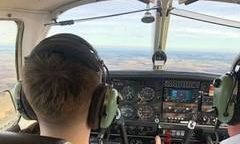Pilots do not consider stress levels to be as great a risk to flight safety as other factors, such as bad weather, according to new research from Aberdeen University.
The findings contrast with guidance from flight safety bodies, which states that stress can compromise pilots’ performance.
Pilots on General Aviation (GA) flights – the largest and most dangerous category of flight in the UK – frequently fly for recreational or business purposes and, unlike commercial pilots, often fly alone.
Risk perception and management are therefore key areas of research vital to safety improvement.
A team of researchers from the university’s Applied Psychology and Human Factors (APHF) group, led by Dr Amy Irwin, set out to examine the risk perception of GA pilots and how this impacts decision-making in relation to take-off, specifically in deciding whether it is safe to take-off or not.
The team presented 101 pilots with a series of 12 take-off scenarios across four categories – compromised performance (pilot stressed, fatigued or ill), environmental hazards (thunderstorm, ice, wind), faulty equipment (power, noise, air speed indicator) and missing equipment (checklist, sunglasses, seatbelt).
Pilots were then asked if they would proceed in each scenario and to explain their reasoning.
Dr Irwin said: “The pilots’ reasoning for their decisions suggests that although they were aware of the risks of flying while ill or tired, the pilots considered flight to be a stress relieving activity, and so they were less likely to cancel a flight based on being under stress.
“This is despite guidance from aviation regulatory bodies such as the Federal Aviation Authority indicating that stress can potentially compromise flight performance.
“General Aviation pilots are generally safety conscious, but not all risks are considered equal, so it is important to highlight the potential impact of stress on flight safety going forward to encourage pilots to consider the risks of flying stressed.
“The more we know about how and why GA pilots make decisions and manage risk, the better able we will be to develop interventions and training solutions to improve safety.
“Based on our research it seems apparent that training on the impact of stress on cognition and performance would be useful, along with training in situation assessment and the validity of various risk mitigation strategies.”
The study was published in the journal Aviation Psychology and Applied Human Factors.










